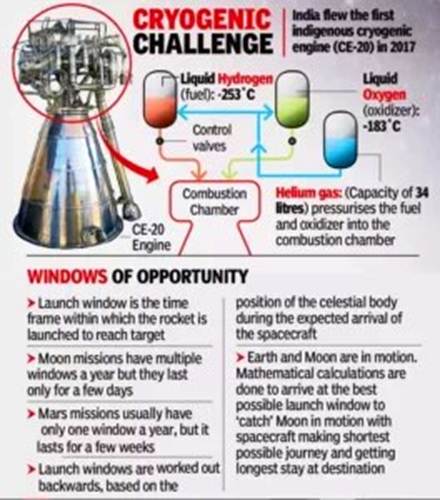Why in News?
- ISRO successfully demonstrated the bootstrap mode start test of the CE20 cryogenic engine on November 7, 2025.
- This marks a major step toward enabling in-flight multiple restarts of the LVM3 (GSLV Mk-III) upper stage engine.
- Enhances mission flexibility, allowing future multi-orbit and Gaganyaan missions to optimize payload deployment and orbital insertion.
Relevance:
- GS 3: Science & Technology — cryogenic propulsion, multi-restart engines, indigenous capability.
- GS 3: Space Technology — applications to Gaganyaan, multi-orbit deployment, heavy-lift missions.

Background:
- ISRO: Indian Space Research Organisation, responsible for India’s space programs and launch vehicles.
- LVM3 (Launch Vehicle Mark-3): Heavy-lift launch vehicle, capable of deploying satellites to GTO/LEO and supporting human spaceflight (Gaganyaan).
- CE20 Cryogenic Engine:
- Powers the upper stage of LVM3.
- Uses liquid hydrogen (fuel) and liquid oxygen (oxidizer).
- Previously qualified for single start operation at thrust 19–22 tonnes.
- Current Start System: Engine ignition uses tank head conditions, with turbo pumps started via stored gas start-up system. Each restart requires additional gas bottles, limiting operational flexibility.
Significance of Bootstrap Mode Start:
- Definition: Engine achieves steady operation without external start-up assistance.
- Advantages:
- Eliminates dependency on additional start-up gas bottles for multiple restarts.
- Enables multi-orbit missions or complex satellite deployments.
- Reduces weight and system complexity on the rocket.
- Enhances reliability and mission safety.
- Test Details:
- Conducted in High-Altitude Test (HAT) facility, ISRO Propulsion Complex, Mahendragiri.
- Duration: 10 seconds under vacuum conditions.
- Demonstrated ability to reach steady operation from bootstrap mode.
Implications for ISRO Programs:
- Gaganyaan Mission: Improves engine restart capability for manned missions requiring orbital maneuvering.
- Future LVM3 Flights: Allows flexible payload deployment across multiple orbits.
- Cryogenic Engine Technology: Demonstrates ISRO’s advanced propulsion capabilities and indigenous mastery of restartable cryogenic engines.
- Strategic Significance: Positions India for advanced satellite launches, space exploration missions, and multi-orbit applications.



